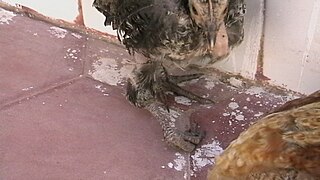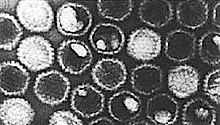Roseolovirus is a genus of viruses in the order Herpesvirales, in the family Herpesviridae, in the subfamily Betaherpesvirinae. There are currently six species in this genus. Diseases associated with this genus include: HHV-6: sixth disease ; HHV-7: symptoms analog to the 'sixth disease'.
Circoviridae is a family of DNA viruses. Birds and mammals serve as natural hosts. There are 101 species in this family, assigned to 2 genera. Diseases associated with this family include: PCV-2: postweaning multisystemic wasting syndrome; CAV: chicken infectious anemia.
Aviadenoviruses are adenoviruses that affect birds—particularly chickens, ducks, geese, turkeys and pheasants. There are 15 species in this genus. Viruses in this genus cause specific disease syndromes such as Quail Bronchitis (QB), Egg Drop Syndrome (EDS), Haemorrhagic Enteritis (HE), Pheasant Marble Spleen Disease (MSD), and Inclusion Body Hepatitis (IBH). Avian adenoviruses have a worldwide distribution and it is common to find multiple species on a single farm. The most common serogroups are serogroup 1, 2 and 3.

Mardivirus is a genus of viruses in the order Herpesvirales, in the family Herpesviridae, in the subfamily Alphaherpesvirinae. Chickens, turkeys, and quail serve as natural hosts. There are six species in this genus. Diseases associated with this genus include: Marek's disease, which causes asymmetric paralysis of one or more limbs, neurological symptoms, and development of multiple lymphomas that manifest as solid tumors. Gallid herpesvirus 2 is the only one of these viruses known to be pathogenic and due to the antigenic similarity between the three viruses the other two have been used to vaccinate against Marek's disease. These viruses have double stranded DNA genomes with no RNA intermediate.

Alphaherpesvirinae is a subfamily of viruses in the family Herpesviridae, primarily distinguished by reproducing more quickly than other subfamilies in the Herpesviridae. In animal virology the most important herpesviruses belong to the Alphaherpesvirinae. Pseudorabies virus is the causative agent of Aujeszky's disease in pigs and Bovine herpesvirus 1 is the causative agent of bovine infectious rhinotracheitis and pustular vulvovaginitis. Mammals serve as natural hosts. There are currently 45 species in this subfamily, divided among 5 genera with one species unassigned to a genus. Diseases associated with this subfamily include: HHV-1 and HHV-2: skin vesicles or mucosal ulcers, rarely encephalitis and meningitis, HHV-3: chickenpox (varicella) and shingles, GaHV-2: Marek's disease.

Gallid alphaherpesvirus 1 (GaHV-1) is a species of virus in the order Herpesvirales, family Herpesviridae, subfamily Alphaherpesvirinae, and genus Iltovirus. Originally recognised in chickens in the United States in 1926, this virus causes avian infectious laryngotracheitis, a potentially fatal, economically deleterious disease, widely recognised as one of the most contagious diseases in the poultry industry. The virus and its associated disease also occur in pheasants.

Duck plague is a worldwide disease caused by Duck enteritis virus (DEV) of the family Herpesviridae that causes acute disease with high mortality rates in flocks of ducks, geese, and swans. It is spread both vertically and horizontally—through contaminated water and direct contact. Migratory waterfowl are a major factor in the spread of this disease as they are often asymptomatic carriers of disease. The incubation period is three to seven days. Birds as young as one week old can be infected. DEV is not zoonotic.
Varicellovirus (var′i-sel′ō-vi′rŭs) is a genus of viruses belonging to subfamily Alphaherpesvirinae, a member of family Herpesviridae. Humans and other mammals serve as natural hosts. There are 19 species in this genus. Diseases associated with this genus include: HHV-3—chickenpox (varicella) and shingles; BoHV-1—infectious bovine rhinotracheitis/infectious pustular vulvovaginitis (IPV); and SuHV-1 —Aujesky's disease.

Atadenovirus is a genus of viruses, in the family Adenoviridae. Vertebrates serve as natural hosts. There are 10 species in this genus.
Muromegalovirus is a genus of viruses in the order Herpesvirales, in the family Herpesviridae, in the subfamily Betaherpesvirinae. Rodents serve as natural hosts. There are three species in this genus. Diseases associated with this genus include: infected peritoneal macrophages, dendritic cells (DC) and hepatocytes, inducing significant pathology in both the spleen and the liver. Murid viruses Murid betaherpesvirus 1 (MuHV-1) and Murid betaherpesvirus 2 (MuHV-2), previously defined as mouse cytomegalovirus (MCMV) and rat cytomegalovirus (RCMV), belong to this genus.
Etapapillomavirus is a genus of viruses in the family Papillomaviridae. Birds serve as natural hosts. There is only one species in this genus: Etapapillomavirus 1. Diseases associated with this genus include cutaneous lesions.
Macavirus is a genus of viruses in the order Herpesvirales, in the family Herpesviridae, in the subfamily Gammaherpesvirinae. Mammals serve as natural hosts. There are nine species in this genus. Diseases associated with this genus include: inapparent infection in their reservoir hosts, but fatal lymphoproliferative disease when they infect MCF-susceptible hosts, including cattle, deer, bison, water buffalo and pigs.
Ostreavirus is a genus of viruses in the order Herpesvirales, and one of only two genera in the family Malacoherpesviridae. Molluscs serve as natural hosts. There is only one species described in this genus, Ostreavirus ostreidmalaco1, also called Ostreid herpesvirus 1 (OsHV-1) and commonly known as oyster herpesvirus. A disease associated with this genus is sporadic episodes of high mortality among larvae and juveniles.
Percavirus is a genus of viruses in the order Herpesvirales, in the family Herpesviridae, in the subfamily Gammaherpesvirinae. Mammals serve as natural hosts. Diseases associated with this genus include: conjunctivitis, immunosuppression in foals, pneumonia, respiratory disease.
Siadenovirus is a genus of viruses, in the family Adenoviridae. Vertebrates serve as natural hosts. There are eight species in this genus.
Thetapapillomavirus is a genus of viruses in the family Papillomaviridae. Birds serve as natural hosts. There is only one species in this genus: Thetapapillomavirus 1. Diseases associated with this genus include cutaneous lesions.
Scutavirus is a genus of viruses in the order Herpesvirales, in the family Herpesviridae, in the subfamily Alphaherpesvirinae. Turtles and tortoises serve as natural hosts. Diseases associated with this genus include fibropapillomatosis.
Aveparvovirus is a genus of viruses, in the subfamily Parvovirinae of the virus family Parvoviridae. There are three species in this genus. Diseases associated with this genus include: enteric disease and malabsorption syndrome.
Batravirus is a genus of viruses in the order Herpesvirales, in the family Alloherpesviridae. Frogs serve as natural hosts. There are three species in this genus. Diseases associated with this genus include: raHV-1: Lucké tumor.
Salmovirus, previously called Salmonivirus, is a genus of viruses in the order Herpesvirales, in the family Alloherpesviridae. Salmonidae serve as natural hosts. There are three species in this genus. Diseases associated with this genus include: salHV-3: epizootic epitheliotropic disease.





